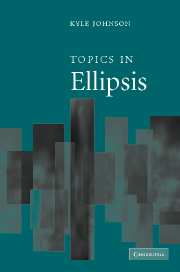Book contents
- Frontmatter
- Contents
- 1 Introduction
- 2 VP Ellipsis and constraints on interpretation
- 3 Direct compositionality and variable-free semantics: the case of Antecedent Contained Deletion
- 4 The view of QR from ellipsis
- 5 Argument Contained Ellipsis
- 6 Variable island repair under ellipsis
- 7 On binding scope and ellipsis scope
- 8 The silent content of bound variable pronouns
- 9 A step-by-step guide to ellipsis resolution
- 10 Shared constituents and Linearization
- Notes
- References
- Index
6 - Variable island repair under ellipsis
Published online by Cambridge University Press: 22 September 2009
- Frontmatter
- Contents
- 1 Introduction
- 2 VP Ellipsis and constraints on interpretation
- 3 Direct compositionality and variable-free semantics: the case of Antecedent Contained Deletion
- 4 The view of QR from ellipsis
- 5 Argument Contained Ellipsis
- 6 Variable island repair under ellipsis
- 7 On binding scope and ellipsis scope
- 8 The silent content of bound variable pronouns
- 9 A step-by-step guide to ellipsis resolution
- 10 Shared constituents and Linearization
- Notes
- References
- Index
Summary
One of the most startling, and hence theoretically challenging, properties of wh-movement in Sluicing is that it can move wh-phrases out of islands, an important observation which goes back to Ross (1969). Equally challenging is the fact that similar wh-movement out of VP Ellipsis sites remains for the most part illicit. Briefly put, it seems that for a wide range of cases, deletion of an IP containing an island voids the effect of that island for wh-movement, while deletion of a VP containing an island does not. This chapter investigates one aspect of this puzzling dichotomy with respect to island repair, and attempts to show that an interesting and partly novel range of data follow if island deviancies come about due to illicit traces of intermediate movement, working in tandem with a constraint on ellipsis operative in structures that host wh-movement. I will argue that a wide range of islands are indeed active at PF, but not in the way that this claim has usually been understood thus far. Instead of the island node itself being responsible for the degradation in acceptability, I will show that the data support the idea that it is the traces of wh-movement outside the island itself which trigger a PF-crash.
I begin with some relevant Background on Sluicing, given in section 6.1, before taking up the Sluicing data in section 6.2 and the VP Ellipsis facts in section 6.3.
- Type
- Chapter
- Information
- Topics in Ellipsis , pp. 132 - 153Publisher: Cambridge University PressPrint publication year: 2008
- 79
- Cited by



